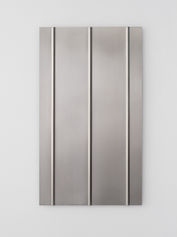
Keith Henning
WATERSPORTS —
Not for public consumption
04 April 2025
-
17 May 2025

WATERSPORTS — Not for public consumption Installation View RESERVOIR 2025

WATERSPORTS — Not for public consumption Installation View RESERVOIR 2025

WATERSPORTS — Not for public consumption Installation View RESERVOIR 2025

WATERSPORTS — Not for public consumption Installation View RESERVOIR 2025
RESERVOIR presents WATERSPORTS — Not for public consumption, a solo exhibition by South African artist Keith Henning. The opening event takes place on Friday, 04 April 2025, and the exhibition runs until 17 May 2025.
This body of work, made from ceramic, steel, and found material, builds on the presentation that the artist created for his post grad diploma at the Michaelis School of Fine Art.
Formally and conceptually, Henning’s work merges together two commonplace architectural objects: the urinal and the fountain. The former is gendered, utilitarian, private, whereas the latter is generic, ornamental, public. By highlighting these tensions, Henning aims to critique how objects can enforce conformity and subdue our instincts for intimacy––especially in those spaces that we take for granted in our everyday lives.
Versions of the urinal have existed since ancient times, serving both a functional and a social purpose. The politics of who is allowed to use the urinal and how it ought to be used implicitly codifies heteronormative and patriarchal structures. Through the enforcement of rigid binaries between male and female, the urinal is often the site where non-normative expressions of gender and sexuality––such as non-binary and trans individuals' use of the object––are policed. Any disruption of the unspoken codes that foment around the urinal can be met with castigation, at best, and, at worst, violence. In fact, its very design––sanitised, sterilised and disembodied––suggests conformity to a status quo that disavows any possibility of play, sensuality, or subversion.
The fountain, on the other hand, holds a more interactive and poetic place in our culture. That is, it has a practical function as well as aesthetic intrigue and spiritual significance. This is why fountains in town squares are often ornately designed, why a coin tossed in fountain water is bound to grant a wish. The fountain is both ordinary and exalted, commonplace and magical. It is a place where people gather to rest, to drink, to splash, to play, or simply to marvel. This is why Henning sees the fountain as a totem for queer liberty. By reintroducing a lost eroticism between these two objects––the fountain and the urinal––Henning’s work celebrates fluidity, reimagining new possibilities for queer visibility and erotic play.
Some of the sculptures provocatively ‘urinate’ into one another. Others are unapologetically phallus-shaped. Stainless steel wall pieces have dry ice hidden inside of them that, when activated, produces condensation, building up a frozen layer––like a colour field atop the steel––before melting. In other words, these are objects that, at first glance, appear to be solid and sterile, like a public restroom, suddenly begin to sweat, to drip, to cry, like bodies. These choices reimagine a public space that reflects––rather than restrains––the body’s natural needs, desires, and expressions. Inspired by the act of cruising––a practice in which individuals seek anonymous or semi-public sexual encounters, often in locations like public parks, restrooms, and other liminal spaces––Henning sees the exploration of desire in an environment that actively suppresses personal intimacy and public exposure as a subversive and sacred act.
This point is reinforced by Henning’s use of materials. Stainless steel, for example, is associated with industry, rigidity, and utilitarianism; it is, accordingly, often seen in institutional or public settings, such as restrooms. Ceramics, on the other hand, evoke domesticity, fragility, and intimacy. By merging the two, his work challenges conventional dichotomies between hard and soft, public and private, utility and sensuality. The interplay between the feminine, organic ceramic curves and the masculine, rigid steel structures further mirrors the tension of dominance and submission in queer sexual roles, which the artist intends as a metaphor for the shifting dynamics of identity and desire.
By considering how public spaces might be used for queer expression and challenging the norms that seek to regulate desire, Henning’s work celebrates difference and intimacy. In this way, his practice resonates as both a personal narrative and a collective call to action, advocating for a world in which all expressions of identity can thrive openly and without fear.
















